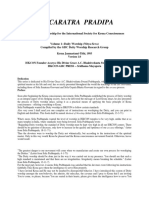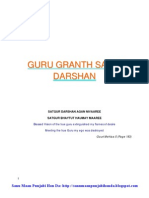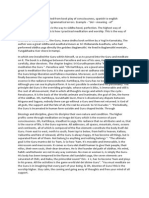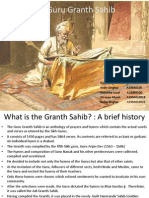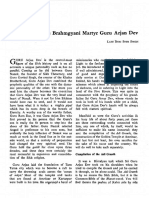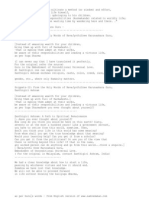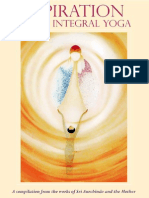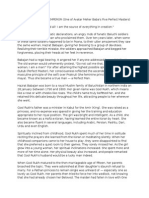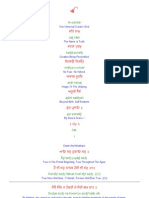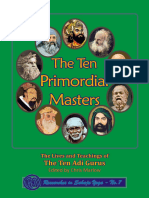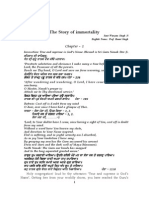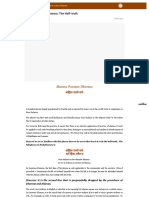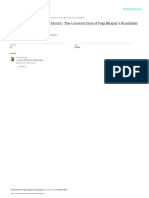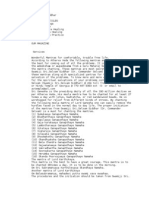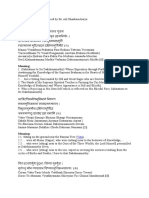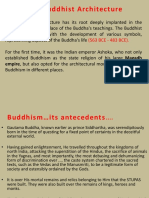Guru Granth Sahib
Guru Granth Sahib
Uploaded by
Richa BudhirajaCopyright:
Available Formats
Guru Granth Sahib
Guru Granth Sahib
Uploaded by
Richa BudhirajaOriginal Description:
Copyright
Available Formats
Share this document
Did you find this document useful?
Is this content inappropriate?
Copyright:
Available Formats
Guru Granth Sahib
Guru Granth Sahib
Uploaded by
Richa BudhirajaCopyright:
Available Formats
Guru Granth Sahib The Guru Granth Sahib (Punjabi: [u nt shb]), is the sovereign active living Guru of the
the Sikhs.[1] It is a voluminous text of 1430Angs, compiled and composed during the period of Sikh gurus, from 1469 to 1708.[1] It is a collection of hymns (Shabad) or Baani describing the qualities of God[2] and why one should meditate on God's nm. Guru Gobind Singh (16661708), the tenth guru, after adding Guru Tegh Bahadur'sbani to the Adi Granth[3][4] affirmed the sacred text as his successor, elevating it to Guru Granth Sahib.[5] The text remains the holy scripture of the Sikhs, regarded as the teachings of the Ten Gurus. [6] The role of Guru Granth Sahib, as a source or guide of prayer,[7] is pivotal in Sikh worship. The Adi Granth, the first rendition, was first compiled by the fifth Sikh guru, Guru Arjan (15631606), from hymns of the first five Sikh gurus and 15 other great saints, or bhagats, including those of the Hindu and Muslim faith.[2] Guru Gobind Singh Ji, the tenth Sikh guru added all 115 of Guru Tegh Bahadur's hymns to the Adi Granth and this second rendition became known as the Guru Granth Sahib.[8] After the tenth Sikh guru died many copies were prepared for distribution by Baba Deep Singh Ji and Bhai Mani Singh Ji.[9] It is written in the Gurmukh script
History Meaning and role in Sikhism[edit source] Sikhs consider the Granth to be a spiritual guide for mankind, and it plays a central role in "guiding" the Sikhs' way of life. Its place in Sikh devotional life is based on two fundamental principles: that the text is divine revelation,[15] and that all answers regarding religion and morality can be discovered within it. Its hymns and teachings are called Gurbani or "Word of the guru" and sometimes Guru ki bani or "Word of God". Thus, in Sikh theology, the revealed divine word is written by the past Gurus.[16] There are numerous holy men, other than the Sikh Gurus, who are collectively referred to as Bhagats, or "devotees." Their writings were included in the Adi Granth and are referred to as Bhagat bani, "Word of Devotees". These saints belonged to different social and religious backgrounds, including Hindus and Muslims, cobblers and untouchables. Guru Granth Sahib is said to be the sole and final successor of the line of gurus.[17]
Composition[edit source]
Main articles: Gurmukh, Sikh music, and Ragas in the Guru Granth Sahib
A composition or Shabad from the Guru Granth Sahib.
The Sikh Gurus spoke Punjabi and developed a new writing script for the language, Gurmukh, for writing their sacred hymns.[21] Although the exact origins of the script are unknown,[22] it is believed to have existed in an elementary form during the time of Guru Nanak. According to Sikh tradition,Guru Angad invented the script,[21] and popularised its use among the Sikhs. It is stated in Mahman Prakash, an early Sikh manuscript, that the script was invented by Guru Angad at the suggestion of Guru Nanak during the lifetime of the founder. [23] The word Gurmukh translates as "from the mouth of the Guru". The script was used, from the outset, for
compiling Sikh scriptures. The Sikhs assign a high degree of sanctity to the Gurmukh language script;[24] it is also the official script for the Indian State of Punjab.
The end part of the handwritten Adi granth, by Pratap Singh Giani, located on the first floor of Harmandir Sahib
The Guru Granth Sahib is divided by their musical setting in different ragas[25] into fourteen hundred and thirty pages known as Angs (limbs) in Sikh tradition. It can be categorized into two different sections: 1. Introductory section consisting of the Mul Mantra, Japji and Sohila composed by Guru Nanak 2. Compositions of Sikh Gurus followed by those of Different Bhagats who just know Only the God, collected according to chronology of ragas or musical notes (see below). The word raga refers to the "color,"[26] and more specifically the emotion or mood prodcuced by a particular combination or sequence of pitches.[27] A raga is composed of a series of melodic motifs, based upon a definite scale or mode of the 7 Swara solmization,[28] that provide a basic structure around which the musician performs. Some ragas may also be associated with different times of the day and year.[25] The total number of ragas in the Sikh system is thirty one, divided into fourteen ragas and seventeen raginis (less important or less definite ragas). Within the raga division, the songs are arranged in order of the Sikh gurus and Sikh bhagats with whom they are associated. The various ragas are, in order: Sri, Manjh, Gauri, Asa, Gujri, Devagandhari, Bihagara, Wadahans, Sorath, Dhanasri, Jaitsri, Todi, Bairari, Tilang, Suhi,Bilaval, Gond (Gaund), Ramkali, Nut-Narayan, Mali-Gaura, Maru,[disambiguation needed] Tukhari, Kedara, Bhairav (Bhairo), Basant, Sarang, Malar, Kanra, Kalyan, Prabhati and Jaijawanti. In addition there are twenty-two compositions of Vars (Traditional ballads). Nine of these have specific tunes and the rest can be sung to any tune.[25]
BOUNDLESS SCRIPTURE OF GURU GRANTH SAHIB
The Guru Granth Sahib is a sacred scripture of the world and is the Eternal Guru of the Sikhs. Because it is a scripture suitable of a universal religion, many world class philosophers and holy men consider it a unique treasure and a noble heritage for all humankind. Because, it is the Guru of the Sikhs, its adoration or veneration is an article of faith with the Sikhs. In the year 2004, the world will celebrate the QuadCentennial of the Granths First Compilation. In 2008, the Sikhs will celebrate the Tercentennial of t he Canonization of the Granth as the Sri Guru Granth Sahib. The sacred verses of Sri Guru Granth Sahib are called Gurbani, which means the Guru's word or the song messages enshrined in Sri Guru Granth Sahib. In Sikhism, the Guru is the 'Wisdom of the Word' and not a human or a book. God revealed the Word through the holy men and women from time to time, and the most recent revelations were entered in the text of Sri Guru Granth Sahib. To the Sikhs, any scripture not included in the Guru Granth is unacceptable as the Gurus word or authority behind their theology, and it is not allowed to be recited, sung, or discussed in Sikh congregations with only exception for the compositions of Guru Gobind Singh, Bhai Gurdas and Bhai Nand Lal. These were considered to elucidate the Guru Granth verses. Those who explain the scripture or teach the doctrines contained in the scripture are respected as teachers, granthi, missionaries, saints or enlightened souls in the Sikh religion. The Sikhs regard Sri Guru Granth Sahib as a complete, inviolable and final embodiment of the message for them. There is to be no word beyond the Word. And that's how their last guru, Guru Gobind Singh, spoke to the congregation on October 20, 1708 shortly before his ascension. "Those who desire to behold the Guru should obey the Granth Sahib. Its contents are the visible body of the Guru." Sri Guru Granth Sahib contains hymns of 36 composers written in twenty-two languages employing a phonetically perfected Gurmukhi script on 1430 pages in 511,874 words, 1,720,345 characters, and 28,534 lines. It has been preserved in its original format since its last completion by Guru Gobind Singh in
1705. It is well known that religious institutions protect themselves from erosion by enshrining their tenets and doctrines in some tangible form. The best and the most modern form of preserving the doctrinal purity today is the use of printed media and electronic storage. At the time of the Granths compilation, the Sikh
gurus could make use of only handwritten books, and they used this medium wisely. If available, all of the founders and the followers of great religions would have liked to compile one volume of their scriptures, as the Sikh gurus did, to preserve their scriptures for posterity. Guru Granth was composed in poetry perhaps to both prevent alterations or adulterations, and to reach out to human heart. According to some writers, its power is the p ower of the puissant and winged word, and no exegesis or commentary or translation can ever convey the full beauty of its thought and poetry. Further, poetry can be left to the culture and the times that follow to best interpret the message. Thus the Guru Granth incorporates all of the features to place it alongside the world's greatest scriptures. Besides, this is the only scripture which in spite of its interfaith nature was dictated, edited, proof-read, and signed for authenticity by the founders of the faith in their life time. These unique features helped preserve the Sikh religion throughout the numerous onslaughts it endured over the period of five centuries. The Granth proved to be a sufficiently foolproof means for continuously providing safeguard against adulteration and extinction of the Sikh religion for centuries to come. The fifth Sikh Guru, Arjan Dev first compiled the Guru Granth in I604 in the city of Amritsar. Guru Gobind Singh prepared the second edition, which he completed at Damdama, a town in the State of Punjab in India in 1705. Since then, his authorized version has been transcribed and printed numerous times; it always conforms to the Damdama edition in every respect. More recently the text in its original font is available electronically on many web sites for every one to have free access. In addition to the edition in original Gurmukhi script, the Guru Granth on the web is available in Hindi, Sindhi, and roman English transliterations. Whereas translations in English, French, Spanish, Punjabi, Hindi, Sindhi and German are already available, those in Thai, Urdu, Hebrew and many Indic languages are in preparation. The Granth compiled by Guru Arjan contained the hymns of the first five Gurus along with most of the saints and holy men of medieval India and the Far East. He installed this scripture in the Sikhscentral shrine, Hari Mandar, at the City of Golden Temple in 1604. Later, this copy was taken into possession by gurus rivals who would not wish to share it freely with the mainstream Sikhs. Guru Gobind Singh took upon himself to recreate the entire Granth. He dictated to a Sikh scholar, Bhai Mani Singh, all verses he considered revealed including the hymns written after Guru Arjan. It took him nearly five years at Anadpur Sahib and Damdama Sahib to complete this project in 1705. He founded Dandama town to immortalize this occasion. On October 20, 1708 Guru Gobind Singh gave his final sermon that conferred permanent gurudom on the Damdama version of the Granth. He selected town of Naderh several hundred miles away from Damdama for this event. Since that day, the Granth has come to be known as Sri Guru Granth Sahib. Sri Guru Granth Sahib contains 5894 hymns. Guru Arjan contributed the largest number of 2216 hymns. Besides the hymns of other Gurus, he also included 937 hymns of fifteen other saints and eleven poet laureates of the Gurus court whose compositions tallied with the gospel of the Sikh faith. Here, the Hindu, the Muslim, the Brahmin, and the untouchable, all meet in the same congregation of holy souls to create a truly universal scripture for our world. From the linguistic point of view, Sri Guru Granth Sahib is a treasury of the languages of its times that communicated well with every segment of the society. The language principally employed is the language of the saints, evolved during the medieval period. Based upon the local dialects, it was leavened with expressions from Sanskrit, Prakrit, Persian, Arabic, Bengali and Marathi etc. This language allowed for variations and still enjoyed wide currency in Southeast Asia. Its appeal is found in its directness, energy and resilience. In addition, the Guru designed a phonetically complete gurmukhi font to meet the need of inscribing the multi-linguistic scripture that is also musical. The poetry of the Granth is in itself a subject worthy of the highest consideration. Music forms the basis of the rhythms and classification of the hymns. They follow a definite metrical system called raags. A raag
in Indian classical music means a pattern of melodic notes. This form is not only used to preserve the originality of the composition, as the poetry written in this form is difficult to imitate, but more so to provide the divine experience through the medium of music and the sounds of Gods creation. The total number of ragas is 31. The gurus themselves invented some of those. Under each Raag, the hymns are arranged in different meters as Chaupadas and Ashtapadas; long poems include Chhands, Vars, and Bhagat verses. Another outstanding feature of the Guru Granth is the rescission and beauty of its prosody. Whilst a great deal of it is cast in traditional verse forms (e.g. shlokas and paudis), and could best be understood in the context of the well-known classical raags, several hymns and songs make use of popular folklore and meters (e.g. alahanis, ghoris, chands, etc.). The inner and integral relationship between music and verse has been maintained with scholarly rectitude and concern. The complete musicalization of thought was accomplished in a scientific and scholarly manner so that it makes for the unusually vigorous yet supple discipline of the Granth's own metrics and notations. The Guru Granth verses are often sung in a process known as kirtan. In this process true meaning is revealed directly to the Surat (consciousness and awareness) through cosmic vibrations. The bodys energetic vibrations from our voices bond us to the spiritual light of universal intelligence. As we chant the Granths verses the universe speaks to us in metaphoric images. The physical body of the singer experiences the essence of each word through the lightening energy in the brain and the calming vibrations in the body, all caused by the sound currents. They keep the mind to stay focused on the Word. They heal the physical body and cleanse inner thoughts. The sound waves of the Gurmat Raags connect the mind, body, and spirit by alignment of the physical, emotional, mental, and spiritual entities. They implant in the psyche the basis for both spiritual and mental growth. To see a Sikh congregation chant the sacred hymns in unison is to see massed spiritual energy bubble before your eyes. This is how the ordinary words change into the logos and become auspicious. Reading of Sri Guru Granth Sahib, known as Gurbani paath, is a sacred rite for every Sikh that permits a connection to the Guru for spiritual guidance. It is more than a simple ritual or a complex scholarly endeavor; intellectual deliberation is engaged to seek wisdom while faith is cultivated in the process to receive the inner light. Reading the rhythmic poetry of Guru Granth is considered by some as healing in itself. Its chant is frequently prescribed to patients for relief of their symptoms and to reduce illnesses. It seems to facilitate understanding of pain and pleasure by mindfulness or being in the moment. In mystic literature of Guru Granth the appeal of the numinous becomes ineffable, if not inexplicable. And yet the great Sikh scripture is not a knot of metaphysical riddles and abstract theorizing. For the most part it employs the idiom of the common people, and draws its imagery and metaphors from the home, the street and the work place. The hymns of the Guru Granth show an admirable use of the current figures of speech apart from their metrical richness and sweetness. Imagery was taken from everyday life and common occurrence to simplify subtle thoughts and profound concepts. The Gurus were keen lovers of nature and as such, have written glowing descriptions of panoramic environmental beauty, changes in the times of day, and the changes of seasons to inculcate love for the One Creator. Thus they made Guru Granth poetry an extraordinary breed of divinity, mysticism, immediacy, concreteness and urgency with which it touches the human heart. One of the greatest glories of the Guru Granth is its all-embracing character. It is a scripture completely free from bias, animus and controversy. Indeed, the uniqueness of the Granth in this respect is all the more astonishing when we think of the obscurantism, factionalism and religious fanaticism of the periods in which it was composed. They were all counterbalanced by inclusion of the songs and verses of a wide diversity of holy men, saints, savants and bards. Of course, their hymns and couplets rendered in their own language and idiom were so dovetailed as to find a complete correspondence with themes or motifs in the compositions of the Sikh Gurus.
The Guru Granth, then, is unique in that it formed the first interfaith and still universal scripture. It is indeed a magnificent compendium of the religious, mystic and metaphysical poetry written or recited between the I2th and 17th centuries in different parts of the Mid-Eastern and Far-Eastern continents. It is also at the same time a reflection of the sociological, economic and political conditions of the day. The satire on the reactionary rulers, the obscurantist clergy, the fake fakirs and the like is uncompromising and telling. In showing the path to spiritual salvation, the Guru Granth does not ignore the secular and creative life of living beings. In addition to its mysticism and spiritual depth, the poetry of the Gurus throws light on their contemporary situations. It lays bare the corruption and degradation of the society of those times and underscores the need of social reform and economic uplift. Guru Granth verses advocate a spiritual soul for their otherwise inhumane administration of the then rulers. Obviously, the idea of Guru Arjan Dev was to celebrate the diversity in all religions and mystic experiences, and, at the same time, establish the fundamental unity of spirituality and faith through the scripture of Sri Guru Granth Sahib. In this scripture he founded an integral congress of all minds and souls operating on the same spiritual vibration. He elevated the songs of the saints, the Sufis and the bards to the elevation of the logos to salute the power of the Word whatever form it might take to reveal the glory of the One Reality. The Sikhs in particular and the religious world in general must be congratulated to be the recipients of the unique scripture of Sri Guru Granth Sahib. We, the Sikhs, must be humble and grateful to be chosen by Guru Gobind Singh who assigned us the task of the keepers of the light of Sri Guru Granth Sahib on this Day of October 20, 1708.
Teachings from Guru Granth sahib
on: June 19, 2009, 06:22:14 AM
Honest Living and Labor They who eat the fruit of their own labor and share with others are the people who have found the right way, O Nanak. Man becomes what he loves best. Equality of Gender How can you call woman inferior, She is the one who gives birth to great men. Service There can be no love of God without active service When one does active service in this world, then alone he achieves salvation Those who meditate on Him, serve humanity Unity of Mankind We all have common father, so we are all his children There is only one human race Truthful Living
Truth is higher than everything, but higher still is truthful living Self Realization One who knoweth one's own self, recogniseth God By conquering the mind thou shalt conquer the whole world One who knoweth the meaning of soul, knoweth Supreme Essence On my soul thou hast emanated from the Light of God, know thy true essence The supreme lord is realizable within the soul Egoism Egoism is deep-rooted disease (causing suffering) When mind is defiled with sin, it is purified by the love of the Name. The perverse cannot offer devotion from their hearts, they are destroying themselves in ego Prayer Prayers from the true heart never go in vain. The mind's pain goeth when one offereth praises to Him in one's prayers. Human Relations Let all be called high, as no one seemteth low. From one light hath come the whole world, so who is good and who is bad. Measure the value of people in terms of their spiritual stature, and not in terms for their caste. Every work or profession is noble if performed in the right way. Sweetness and humility are the essence of all goodness and virtue.
Sikh Gurus > Guru Granth Sahib Ji
Guru Granth Sahib Ji is the holy scripture and present Guru of Sikhs. Guru Granth Sahib Ji is considered the word of God, Guru Nanak Dev Ji, the first Sikh Guru conveyed that anything he narrated was narrated under the authority of the creator, God. Everything written in Guru Granth Sahib Ji is in it's original form, unaltered, uninterpreted, and untranslated. Seeing the interpretations of holy scriptures in other religion, and different denominations creating their own version of the holy scriptures, it was imperative that Guru Granth Sahib Ji must be kept in it's original form so that no sub versions or interpretations are created later on.
Guru Granth Sahib Ji is very easy to read and understand. The wording in Guru Granth Sahib Ji often called Gurbani, meaning the Word of Guru, contains countless anecdotal references and analogies. Although various English translations of Guru Granth Sahib Ji are available, the original form and content of Guru Granth Sahib Ji remains unchanged since it's compilation. Guru Granth Sahib Ji has deep meanings and in order to understand these meanings, one should read the original non-translated text. It might be a little hard to understand the text at first but as you build vocabulary by looking for the meaning of the words in Guru Granth Sahib Ji, the text becomes easier and easier to understand. The Language Guru Granth Sahib Ji is written in its entirety in Gurmukhi which translated means from the mouth (Mukh) of the Guru. Gurmukhi was developed by the first Guru and then promoted by his successors, it was a language spoken and understood by all classes of people, the Guru hoped for the scriptures to be accessible by all. Guru Granth Sahib Ji also contains hymns which are written in a language known as Sahiskriti as well as Sant Bhasha, it also contains many Persian and Sanskrit words as well. The simpler form of Gurmukhi is now known as Punjabi. The Content Guru Granth Sahib Ji contains hymns written by Sikh Gurus and devotees of God who themselves have attained salvation. They write about their experiences and the life they lead to meet God. The scripture, which is 1430 pages in length, is also composed almost wholly in musical scale and meter and is completely written in poetic verse. Guru Granth Sahib Ji contains answers to question like: Who is God? What does God look like? How to meet Him? What happens after death? How to live a lifestyle what would lead to meeting God? All answers on this site have been taken from the information in Guru Granth Sahib Ji. Guru Granth Sahib Ji also states remarkable information about the universe, galaxies, stars, planets and the moons. None of the information written in the scripture contradicts with the scientific facts. Scientific facts have been supporting the teachings of Guru Granth Sahib Ji. Guru Granth Sahib Ji further explains how God created the Universe. In addition, this is not the first time God created the Universe. He has created the Universe and life in the Universe many times. All life on the Earth is a creation of God and has been evolving since. Furthermore, life is not just limited to the Earth. Since the writers of Guru Granth Sahib Ji themselves attained salvation, they write how you can meet God as well and attain salvation yourself. Many devotees have written about their journey and longing to meet God and about their Union with God as well. The Contributors Guru Granth Sahib Ji contains the Bani (compositions) of 7 Sikh Gurus and many devotees of God regardless of their original religion. It is said that once they became devotees of God, they were not some person from a religion but a spiritual learner of God. Kabir Ji himself said, 'I am not a Hindu or a Muslim, I am just a common person.' Guru Arjan Dev Ji has the most hymns in Guru Granth Sahib Ji. Following is the list of all contributors and the amount of hymns contributed.
Contributor Name Guru Nanak Dev Ji Guru Angad Dev Ji Guru Amar Das JI Guru Ram Das Ji Guru Arjan Dev Ji Guru Tegh Bahadar Ji Guru Gobind Singh Ji Bhagat Kabir Bhagat Naamdev Bhagat Sain Bhagat Ravi Das Bhagat Trilochan Bhagat Dhana Bhagat Farid Bhagat Beni Bhagat Jai Dev Bhagat Bhikhan Bhagat Sur Das Bhagat Parmanand Bhagat Pipa Bhagat Sadna Bhagat Ramanand Bhagat Sundar Bhat Kal Bhat Kalsehar Bhat Tal Bhat Jalup Bhat Jal Bhat Kirat Bhat Sal Bhat Bahil
Shabads (Hymns) 974 63 907 679 2218 116 1 541 60 1 41 4 4 134 3 2 2 2 1 1 1 1 6 49 4 1 4 1 8 3 1
Bhat Nal Bhat Bhikha Bhat Jalan Bhat Kas Bhat Gend Bhat Sevak Bhat Mathra Bhat Bal Bhat Harbans Bhai Mardana Bhai Sata and Bhai Balvanda The
6 2 1 14 5 7 10 5 2 3 8 History
Guru Nanak Dev Ji's writings were kept by his companions including Bhai Mardana. Baba Buda and Bhai Datu - both followers of the Guru are also known in the history to have kept records of the Guru's Bani. When Guru Angad Dev Ji was enthroned as the second Guru, he was given a 'pothi' - a book which contained hymns of Guru Nanak and some Bhagats such as Bhagat Kabir and Bhagat Farid. This Pothi is not available today.
Guru Angad Dev Ji bought together the Bani composed by his predecessors, and recited them to Bhai Paira Mokha who scribed these to form another Pothi. This Pothi was passed to Guru Amar Das Ji, the third guru of Sikhs. Guru Amar Das Ji compiled all the Banis of his predecessors into another Pothi.
The Bani was passed down to Guru Ram Das Ji and then to Guru Arjan Dev Ji. Guru Arjan Dev Ji, the fifth Guru of sikhs, then built a tent near the Harmandir Sahib (The Golden Temple), which was then under construction. The Guru called for Bhai Gurdas, a renown and respected Sikh scholar, for the purposes of compiling all the compositions of his predecessors and devotees of God. This version came to be known as the Adi Granth. At that time, the emperor of Hindustan (India) was Akbar, he received complaints alleging that the fifth Guru had compiled a Holy Book which was detrimental - not only to the Hindu faith, but to Islam also. Emperor Akbar asked that the Guru appear before him to answer
these complaints. The Guru sent Baba Buda and Bhai Gurdas to answer the Emperor. The Emperor, who is said to have most liberal views among all emperors in the history of India, asked that some passages from the Holy Granth be read to him so that he can decide whether the contents of the Granth was offensive or not. Baba Buda then read shabads from the Holy Granth. Akbar was very pleased with the content which embraced an acceptance of God regardless of religion and sent a message of peace and unity. He gifted two gold coins to the scripture and robes for the two representatives and a robe for the Guru. The Emperor later visited the Guru during a tour of Punjab.
When Guru Gobind Singh Ji was enthroned as the tenth Guru, he completed the final version of the holy scripture. Guru Gobind Singh Ji added the Shabads of the ninth Guru, Guru Tegh Bahadur Ji and one Salok (couplet) of his own to the Adi Granth. Before the tenth Guru passed away, he bestowed this version of the Granth as the final and everlasting Guru. It then became known as the Guru Granth Sahib Ji. Guru Gobind Singh Ji said, whoever longs to meet God, find the way in the Shabad (Guru Granth Sahib Ji). The Message
Guru Granth Sahib Ji gives a peaceful message to the entire world. It states that you cannot reach God just by belonging to a certain religion or following a certain religion, you have to have moral values, help the less fortunate, live a truthful life, and most importantly, meditate on God.
"All beings and creatures are His; He belongs to all" (Guru Granth Sahib Ji, 425). As the color of safflower is impermanent and is washed away in water, likewise the colors of religiosity are also temporary. There are no religions beyond this world.
If one seeks to meet God and attain eternal peace, he or she should read Guru Granth Sahib Ji. The scripture does not preach Sikhism or tells people to convert to Sikhism but gives an amazing, mind opening and enlightening information about God and His creations. In addition, Guru Granth Sahib Ji shows everyone a straight path to attain salvation regardless of their background or religion.
Sri Guru Granth Sahib
The Guru Granth Sahib contains the scriptures of the Sikhs. It is an anthology of prayers and hymns which contain the actual words and verses as uttered by the Sikh Gurus. The Guru Granth Sahib, also known as the Adi Granth, consists of 1430 pages and has 5864 verses. Its contents are referred to as bani or gurbani. An individual hymn is a shabad. The Granth was compiled by the fifth Sikh guru, Guru Arjan Dev ji. He undertook the enormous task of collecting, compiling, and scrutinizing the hymns and compositions of Guru Nanak and his predecessors. He decided to include not only the hymns of the Gurus but also that of other saints. At the invitation of the Guru, followers of different sects, both Hindu and Muslim, came to the Guru and recited the hymns of their teachers. Guru Arjan chose only those hymns which echoed sentiments he wanted to inculcate in his own community. After the selections were made, the Guru dictated the hymns to Bhai Gurdas ji, who wrote the Granth Sahib. Having compiled the Granth, the Guru placed it in the newlybuilt Harmandir Sahib (Golden Temple) in Amritsar. The first parkash (opening ceremony) was performed in the Golden Temple by Guru Arjan on August 30, 1604. The Guru nominated Bhai Buddha as the custodian of the Granth Sahib. At this time, the Guru bowed before the collection, acknowledging the higher authority of the bani to that personal importance and significance which he possessed as Guru. After this time, he no longer sat at a level above the Granth Sahib, but below it. The Guru also instituted daily public worship at the temple where the Granth was recited all day long to the accompaniment of stringed musical instruments (kirtan). With the passage of time, the original Granth Sahib passed on from Guru Arjan to Guru Hargobind and then to his grandson, Dhir Mal, who took permanent possession of it. To restore the Granth compiled by Guru Arjan to the Sikhs, Guru Gobind Singh ji sent some Sikhs to Dhir Mal's descendants, who possessed the original Granth Sahib, and requested for its return. But they refused to part with it and asked the Guru to write his own Granth if he was a real Guru. Therefore, the second version of Guru Granth Sahib was prepared by Guru Gobind Singh in 1706. At Damdama Sahib, Guru Gobind Singh dictated the entire Granth Sahib from his memory to Bhai Mani Singh ji; the Granth Sahib was dictated word by word as it originally was. At this time, Guru Gobind Singh re-edited the Adi Granth to the form in which we find it today. The Guru removed some unauthenticated writings in the Granth and added four hymns in the beginning for evening prayers. Guru Gobind Singh also added several hymns from his father, Guru Tegh Bahadur. Otherwise, the Granth was left as it was before in the days of Guru Arjan.
Several copies of this Granth were transcribed by hand by Baba Deep Singh ji at Damdama Sahib. It is believed that four copies of the Granth Sahib were prepared; the first one was sent to the Harimandir Sahib at Amritsar, the second to Anandpur, the third to Patna and the fourth was kept by Guru Gobind Singh at Nander. Guru Gobind Singh ended the line of living Sikh Gurus by raising the Adi Granth to the status of a permanent Guru. Guru Gobind Singh ji transmitted Guru Nanak's divine light into the divine Word and declared that after him, the next Guru would be Guru Granth Sahib. He commanded the Sikhs that it was to be revered as the body and spirit of the ten Gurus:
Agia bhai akal ki, tabi chalaio panth Sab sikhan kau hukam hai guru manio granth Guru granth ji manio pargat guran ki deh Ja ka hirada sudh hai khoj sabad men leh From the Timeless One there came the injunction, In accordance with which was established the Panth. To all Sikhs there comes this command: Acknowledge the Granth as Guru, For it is the manifest body of the Masters. Ye whose hearts are pure, Seek Him in the Word. (Ardas)
When the Guruship was passed on, Guru Granth Sahib like the Gurus became the embodiment of Divine Light. It should, therefore, be remembered very clearly that bowing before Guru Granth Sahib as Sikhs, is not bowing before a book, but it is a bowing before the Divine Light or Jot (Guru) which was passed on when the Guruship was conferred upon it. Respect and veneration for Guru Granth does not imply idol worship, but rather respect for a divine message, the ideas and ideals contained in the Sikh scripture. It is the source or a means to the worship of God through His Word, and not an object of worship in itself. Both the Gurus and the Book deserve the respect which they are accorded because of the bani which they express, the word of divine truth. Bhai Gurdas ji states that "the picture of the Guru is the gurbani" (Bhai Gurdas, Var 24, pauri 11).
Revelation In The Guru Granth Sahib
Guru Granth Sahib is a remarkable storehouse of spiritual knowledge and teachings which does not preach any rites or rituals but stresses meditation on the Name of God; salvation can be obtained by means of regular, persistent and disciplined meditation. Most of the hymns are addressed to God and often describe the devotee's condition: his aspirations and yearning, his agony in separation and his longing to be with the Lord. There are no mythological narratives, although God is described in anthropomorphic terms and the Gurus
are not afraid to use the imagery of family relationships to describe the union of God and man. The subject of Guru Granth Sahib is truth: how to become a 'person of truth', that is, an ideal person or gurmukh. As Guru Nanak states in the Mool Mantar, God is the Ultimate Truth and one has to cultivate those qualities which are associated with Him. Through its teachings, the Granth can enable men and women to lead a purposeful and rewarding life while being members of a society. It seeks universal peace and the good of all mankind. There is not a word in the Guru Granth Sahib that might be derogatory to any other belief or religion. The Guru Granth Sahib also stresses the democratic way of life and equality of all people. It teaches that we are karam yogis, that is we reap what we sow. The emphasis is on moral actions, noble living and working for the welfare of all people. One of the most distinctive features of the Guru Granth Sahib is that it is the first religious book which contains the writings of persons belonging to different communities, castes, and diverse regions of the country. It incorporates and sanctifies the writings of holy men of different faith. Therefore, the language of the Granth is a mixture of almost all the Aryan languages current in India, yet it is written exclusively in Gurmukhi script. Guru Arjan Dev ji, unlike many other religious leaders, did not believe that there is one particular sacred language in the sense that man can pray to God only in that language. The Granth Sahib contains 937 hymns of 36 Hindu saints, Muslim sufis and bards. The hymns of the these holy men cover a period of six centuries (from the 12th to the 17th century). Regardless of the author, this gurbani has an equal status as the hymns of the Gurus. Kabir Namdev Ravi Das Trilochan Dhanna Sain Jaidev Pipa Sur Das Muslim weaver 292 hymns
Calico printer from Maharashtra 60 Shoe maker from Uttar Pradesh 41 Brahmin from Maharashtra Cultivator from Rajasthan Barber from Uttar Pradesh Poet from Bengal King from Uttar Pradesh Blind poet 4 4 1 2 1 2 134
Baba Farid Muslim saint from Punjab
Parmanand Maharashtra Sadhna Beni Ramanand Uttar Pradesh Bhikhan Sufi saint from Uttar Pradesh Butcher from Sindh
1 1 3 1 2
There are also some hymns from Sikhs during the time of the Gurus, including those from Baba Mardana ji, Baba Sunder ji, Sata Doom, and Rai Balwand. In addition, the Granth Sahib includes some bani from eleven bards (bhats) who came to the court of Guru Arjan in 1580. They were men of wisdom and were much impressed by the personality and the work of the Guru. Their names are Kalashar, Jalap, Kirat, Bhikha, Sal, Mathura, Bal, Bhal, Nal, Gayand, and Harbans. Yet, overall, the majority of bani in the Guru Granth Sahib contains the hymns of the Gurus:
Guru Nanak Guru Angad Dev Guru Amar Das Guru Ram Das Guru Arjan Dev
974 hymns 62 907 679 2218
Guru Tegh Bahadur 115 Guru Gobind Singh 1
Most of the introductory bani in the Granth Sahib is written by the Sikh Gurus. The Guru Granth Sahib starts with Guru Nanak's composition, Mool Mantar followed by Japji, Rehras (the morning and evening prayer respectively) and Kirtan Sohila, the night prayer. This introductory gurbani occupies the first thirteen pages of the Guru Granth Sahib. Jap Ji, also called Guru Mantar, was written by Guru Nanak. It occupies about 9 pages and consists of 40 sloks, called pauries of irregular length. The mode of composition implies the presence of a questionnaire and an answer. Jap Ji is followed by Sodar Rehras, another composition by Guru Nanak, although later on additions were made to it by Guru Ram Das and Guru Arjan Dev. Sodar is the yearning of the soul for the door of the house of God. Kirtan Sohila follows Sodar and occupies a little over one page. It was also composed by Guru Nanak but has additions by Guru Ram Das and Arjan Dev.
The next portion of the Granth is divided into thirty one sections each according to a particular raga. This portion occupies 1154 pages.
Usage of Ragas
The Gurus considered divine worship through music the best means of attaining a state of bliss. Therefore, each of the hymns in the Guru Granth Sahib is noted with the melody and rhythm (raga) to which it is to be sung or read. There are 31 musical measures (ragas) in the Guru Granth Sahib. The selecting of ragas was carefully made by the Guru. Generally speaking, ragas are composed to suit various moods. Some are appropriate to the morning, others to the evening, some to joy, others to grief. Guru Arjan indicated that faith should produce a balanced outlook, tempering both happiness and sadness. Therefore, the Guru omitted those that aroused passions of any kind. Likewise, certain ragas were rejected for their melancholy. The basic concept behind the hymns is that kirtan (sacred music), when sung or listened to with devotion and undivided attention, can link the individual's consciousness with God. A mind may become stable and enjoy the peace of His divine presence, as listening to the hymns can exert a powerful influence on the mind and help to establish its communion with God.
Role of the Guru Granth Sahib in Sikh Life
In all gurdwaras and many Sikh homes, the Granth is read every day. No Sikh ceremony is regarded as complete unless it is performed in the presence of the Guru Granth Sahib. On a daily basis, Sikhs receive a hukam or divine order in the form of a hymn from the Guru Granth Sahib, either in a Gurdwara or at home. The hukam is the first hymn of the holy book from the left hand page when it is opened at random. Similarly, at the end of a service, after the ardas, the Adi Granth is opened at random and a portion is read. Many Sikhs do this daily, regarding the verses as words from God which they will find helpful during the day. This is called vak lao, taking advice. On special occasions, the Granth Sahib is recited non-stop from cover to cover by a string of readers. This continuous reading of the Guru Granth Sahib is known as an akhand path. It is regarded as the highest and the noblest ceremony in the Sikh religion, and can be performed on any important occasion. It requires nearly 48 hours to complete the continuous reading. According to Sikh history, the first akhand path was performed by Guru Hargobind, the sixth Guru, after the death of his wife, Mata Damodri ji. An akhand path was also performed by Baba Deep Singh ji when he pledged before God at Damdama Sahib to sacrifice his life for the protection of human rights. A saptahak path is a daily reading of Guru Granth Sahib to be completed in seven days. It is sometimes undertaken in private homes as a mark of supplication on special occasions. A sehaj path is a reading of Guru Granth Sahib that can be completed at any length of period beyond seven days. Guru Granth Sahib ji remains as a permanent unchangeable guide for all Sikhs as a living Guru or Teacher. It is a representation of the undaunted strength of the Sikh community. Guru Arjan Dev preferred a martyr's death to saving his life through making alterations in the hymns as required by Emperor Jahangir. Any Sikh can open the pages of the Guru
Granth Sahib and find strength and guidance through His Word: "The Guru is now always with me" (Guru Arjan, Rag Asa)
You might also like
- Way of The Saffron Cloud (Mystery of The Nam-Jap) (English) - Read More Books On This Subject by VisitingDocument177 pagesWay of The Saffron Cloud (Mystery of The Nam-Jap) (English) - Read More Books On This Subject by VisitingSingh1430No ratings yet
- PANCARATRA PradipaDocument262 pagesPANCARATRA PradipaHari Sukrawan100% (7)
- Yagnopaveetha Dharana Vidhi With Sloka Manthras (English Script)Document8 pagesYagnopaveetha Dharana Vidhi With Sloka Manthras (English Script)bhargavasarma (nirikhi krishna bhagavan)100% (7)
- Guru Granth Sahib DarshanEngDocument344 pagesGuru Granth Sahib DarshanEngSanu Maan Punjabi Hon Da75% (4)
- Meditation On GuruDocument2 pagesMeditation On Gurubangera23100% (1)
- English Version of Dhan Dhan Baba Isher Singh Ji's BachansDocument9 pagesEnglish Version of Dhan Dhan Baba Isher Singh Ji's BachanshansrabNo ratings yet
- Guru Nanak Dev Ji His Life and Teachings by Kartar Singh PDFDocument335 pagesGuru Nanak Dev Ji His Life and Teachings by Kartar Singh PDFDr. Kamalroop Singh100% (1)
- Shabad Guru - Guru Granth Sahib JiDocument4 pagesShabad Guru - Guru Granth Sahib JiRicha Budhiraja100% (1)
- Red Tara An Open Door To Bliss and UltimDocument6 pagesRed Tara An Open Door To Bliss and UltimMarcos100% (1)
- The Guru Granth SahibDocument13 pagesThe Guru Granth SahibnirvaangNo ratings yet
- As the Sun of Suns Rose: The Darkness of the Creeds Was DispelledFrom EverandAs the Sun of Suns Rose: The Darkness of the Creeds Was DispelledNo ratings yet
- Sikh Scripture: A Revealed Journey to World ReligionsFrom EverandSikh Scripture: A Revealed Journey to World ReligionsNo ratings yet
- It Is the Same Light: The Enlightening Wisdom of Sri Guru Granth Sahib (Sggs) Volume 5: Sggs (P 801-1000)From EverandIt Is the Same Light: The Enlightening Wisdom of Sri Guru Granth Sahib (Sggs) Volume 5: Sggs (P 801-1000)No ratings yet
- Ardas PDFDocument34 pagesArdas PDFDr. Kamalroop Singh100% (1)
- Gurbani Contemplation - Dakhni Oangkaar and Sidh GostDocument225 pagesGurbani Contemplation - Dakhni Oangkaar and Sidh Gostparamjit689792No ratings yet
- Chandi Di Vaar - A DiscussionDocument17 pagesChandi Di Vaar - A DiscussionNihang Jodhbir SinghNo ratings yet
- Se Kinehiya - EnglishDocument488 pagesSe Kinehiya - EnglishKamaljitKaurNo ratings yet
- Sri Kalgidhar Chamatkar (Part 1) (English)Document558 pagesSri Kalgidhar Chamatkar (Part 1) (English)Raj Karega KhalsaNo ratings yet
- Bhai Nand Lal JiDocument76 pagesBhai Nand Lal JiDilpreet SinghNo ratings yet
- UnderstandingJapjiSahib PDFDocument149 pagesUnderstandingJapjiSahib PDFsatinder singhNo ratings yet
- I Am Proud To Be A Sikh Gurbachan Singh Makin PDFDocument107 pagesI Am Proud To Be A Sikh Gurbachan Singh Makin PDFDr. Kamalroop SinghNo ratings yet
- Bijak of KabirDocument258 pagesBijak of KabirSanjay Ananda100% (4)
- The Brahmgyani Martyr Guru Arjan Dev - Sher Singh MSC KashmirDocument7 pagesThe Brahmgyani Martyr Guru Arjan Dev - Sher Singh MSC KashmirSikhDigitalLibraryNo ratings yet
- GuruvaniDocument3 pagesGuruvaniShaje UdayabhanuNo ratings yet
- Anth Sahib Ji by Prof Sahib Singh PDFDocument273 pagesAnth Sahib Ji by Prof Sahib Singh PDFDr. Kamalroop Singh100% (1)
- Japji - EnglishDocument93 pagesJapji - EnglishholaNo ratings yet
- The Region of Grace - Sirdar Kapur SinghDocument10 pagesThe Region of Grace - Sirdar Kapur SinghSikhDigitalLibraryNo ratings yet
- EPdf-Aspiration in The Integral YogaDocument146 pagesEPdf-Aspiration in The Integral YogaVasuramesh Dhayalan100% (1)
- Amrit Velaa: Gyaani Sant Singh Ji MaskeenDocument5 pagesAmrit Velaa: Gyaani Sant Singh Ji MaskeenSikhSangat Books100% (1)
- Autobiography of Bhai Rama Singh Ji (English)Document307 pagesAutobiography of Bhai Rama Singh Ji (English)Sikh Texts100% (2)
- Guru Tegh Bahadur Ji by Ranbir Singh PDFDocument171 pagesGuru Tegh Bahadur Ji by Ranbir Singh PDFDr. Kamalroop SinghNo ratings yet
- Ek Onkar - One GodDocument17 pagesEk Onkar - One GodAnonymous BMo6CXV100% (1)
- Rhrwis Swihb Aqy Kirqn Soihlw: Rehraas Sahib & Kirtan SohelaDocument64 pagesRhrwis Swihb Aqy Kirqn Soihlw: Rehraas Sahib & Kirtan Sohelajagtar singhNo ratings yet
- Hazrat BabajanDocument12 pagesHazrat BabajanKedar KelkarNo ratings yet
- Nitnem by Dr. Kulwant Singh, With Punjabi & Eng Transla & PTDocument322 pagesNitnem by Dr. Kulwant Singh, With Punjabi & Eng Transla & PTParneet Walia100% (1)
- Bibliography of Sri Guru Granth Sahib JiDocument36 pagesBibliography of Sri Guru Granth Sahib JiMahender Singh Griwan100% (1)
- Kalyug Ke KaamiDocument7 pagesKalyug Ke KaamiSikhSangat Books100% (1)
- Guru Nanak's Japji and Sohila-Arti - Prof. Puran SinghDocument34 pagesGuru Nanak's Japji and Sohila-Arti - Prof. Puran SinghSikhDigitalLibraryNo ratings yet
- Prayer: Its Nature & TechniqueDocument140 pagesPrayer: Its Nature & TechniqueWalter SimoNo ratings yet
- Japji SahibDocument40 pagesJapji SahibJatin NagpalNo ratings yet
- Sri Akaal Ustat SahibDocument10 pagesSri Akaal Ustat SahibSikhSangat Books100% (1)
- Mahamudra UpadesaDocument5 pagesMahamudra UpadesaJOHN100% (3)
- Laavan GurbaniDocument13 pagesLaavan GurbaniSimrun Singh AuroraNo ratings yet
- MahavirDocument169 pagesMahavirKailash KothariNo ratings yet
- The Japu of Guru Nanak - Sirdar Kapur SinghDocument4 pagesThe Japu of Guru Nanak - Sirdar Kapur SinghSikhDigitalLibraryNo ratings yet
- Ribhu Gita Chapter 26Document8 pagesRibhu Gita Chapter 26DenisMori100% (1)
- 10 Primordial Masters - 10-22Document276 pages10 Primordial Masters - 10-22alieshashuklaNo ratings yet
- Gems From Guru GitaDocument17 pagesGems From Guru GitaChristian FisherNo ratings yet
- Amar Gatha English by Sant Waryam Singh Ratwara Sahib Wale PDFDocument481 pagesAmar Gatha English by Sant Waryam Singh Ratwara Sahib Wale PDFDr. Kamalroop SinghNo ratings yet
- Kyoshi Mori NTT DocomoDocument20 pagesKyoshi Mori NTT DocomoRicha BudhirajaNo ratings yet
- Network Layer: Logical AddressingDocument45 pagesNetwork Layer: Logical AddressingRicha BudhirajaNo ratings yet
- Uplink Power Based Admission Control in Multi-Cell Wcdma Networks With Heterogeneous TrafficDocument20 pagesUplink Power Based Admission Control in Multi-Cell Wcdma Networks With Heterogeneous TrafficRicha BudhirajaNo ratings yet
- Major TeachingsDocument19 pagesMajor TeachingsRicha BudhirajaNo ratings yet
- Follow Shri Guru Granth Sahib's Teachings and Recite WaheguruDocument2 pagesFollow Shri Guru Granth Sahib's Teachings and Recite WaheguruRicha BudhirajaNo ratings yet
- Point To Point MicrowaveDocument81 pagesPoint To Point MicrowaveRicha BudhirajaNo ratings yet
- Voice Over Internet ProtocolDocument22 pagesVoice Over Internet ProtocolRicha BudhirajaNo ratings yet
- Sri Krishna Kathamrita - Bindu016 PDFDocument4 pagesSri Krishna Kathamrita - Bindu016 PDFjack sparowNo ratings yet
- Ahimsa Paramo Dharma: The Half-TruthDocument5 pagesAhimsa Paramo Dharma: The Half-TruthDeepak yadavNo ratings yet
- Gautama Buddha Was Born in Hela BimaDocument62 pagesGautama Buddha Was Born in Hela BimaTharaka Nadeeshan33% (3)
- NididhyasanamDocument6 pagesNididhyasanamrogerio sanfer100% (1)
- Chapter 2: Sankhya Yoga:, Vaisheshika, Mimamsa and Vedanta)Document3 pagesChapter 2: Sankhya Yoga:, Vaisheshika, Mimamsa and Vedanta)Debarshi Dey100% (1)
- Deslippe-2012-Sikh Formations-From Maharaj To Mahan TantricDocument20 pagesDeslippe-2012-Sikh Formations-From Maharaj To Mahan TantricuribematiasNo ratings yet
- Services - Sri Selvam SiddharDocument7 pagesServices - Sri Selvam SiddharrsesamanaiduNo ratings yet
- 2 YogDocument21 pages2 YogSiddharth AroraNo ratings yet
- Perceive The Presence of Your Self in EveryoneDocument2 pagesPerceive The Presence of Your Self in EveryonemindoflightNo ratings yet
- New - Bhajan - Book 11 09 2017Document57 pagesNew - Bhajan - Book 11 09 2017Rodrigo DeodatoNo ratings yet
- Dakshinamurthy StotramDocument7 pagesDakshinamurthy StotramAnand AbheyNo ratings yet
- Chakra NotesDocument8 pagesChakra NotesArtistHBPNo ratings yet
- 18 PuranasDocument25 pages18 Puranas61srinihemaNo ratings yet
- ParablesDocument77 pagesParablesGlory of Sanatan Dharma Scriptures & KnowledgeNo ratings yet
- What Kind of Buddha Is AmitabhaDocument37 pagesWhat Kind of Buddha Is AmitabhaJuan Carlos HincapieNo ratings yet
- 2023 - 1 - SHIKSHA Krishna - SADHAKA QUESTIONNAIRE 2010 Ver 1.2Document41 pages2023 - 1 - SHIKSHA Krishna - SADHAKA QUESTIONNAIRE 2010 Ver 1.2shamanth sreekanthamNo ratings yet
- Advaita Vedanta Tatwa and Adi Sankaracharya: Ranjan Kumar MishraDocument5 pagesAdvaita Vedanta Tatwa and Adi Sankaracharya: Ranjan Kumar MishraAnggara LesmanaNo ratings yet
- M ST Zieba Buddhist Classification of Dharmas Pancavastuka of VasumitraDocument9 pagesM ST Zieba Buddhist Classification of Dharmas Pancavastuka of VasumitranoychoHNo ratings yet
- Siddhanta Saivam in Essence and ManifestationDocument90 pagesSiddhanta Saivam in Essence and ManifestationSivasonNo ratings yet
- 4,000 Year Old Vishnu Statue Discovered in VietnamDocument7 pages4,000 Year Old Vishnu Statue Discovered in VietnamAmbrish GuptaNo ratings yet
- July 2022 Aradhana Final1Document27 pagesJuly 2022 Aradhana Final1AKASH SINGHNo ratings yet
- Baglamukhi Diksha Vidhi बगलामुखी दीक्षा विधिDocument7 pagesBaglamukhi Diksha Vidhi बगलामुखी दीक्षा विधिsumit girdharwalNo ratings yet
- Sri YantraDocument20 pagesSri YantraRaj Kumar100% (1)
- Soul Retrieval and Ransom/ Liberating AnimalsDocument1 pageSoul Retrieval and Ransom/ Liberating AnimalsGyalshenInstituteNo ratings yet
- Initials in Buddhist Architecture: (563 BCE - 483 BCE)Document51 pagesInitials in Buddhist Architecture: (563 BCE - 483 BCE)MansiGargNo ratings yet
- Vedantasara of Sri Ramanujacharya Translated by V KrishnamacharyaDocument494 pagesVedantasara of Sri Ramanujacharya Translated by V Krishnamacharyaperumal1312No ratings yet
- The Akali Movement by Mohinder Singh PDFDocument261 pagesThe Akali Movement by Mohinder Singh PDFDr. Kamalroop Singh100% (1)

